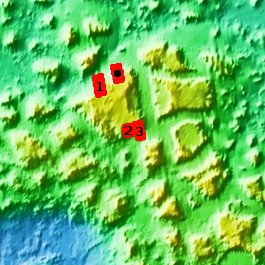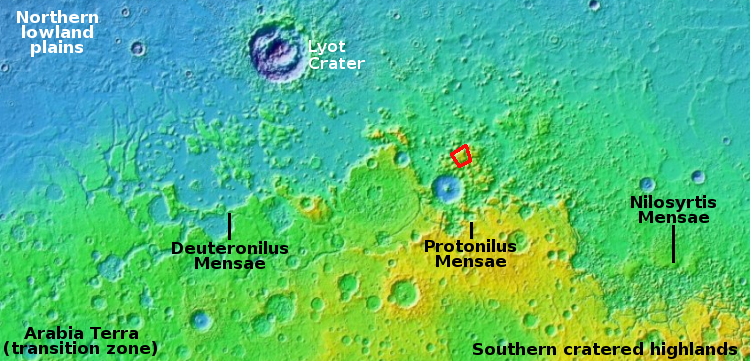Monitoring one glacier flowing off a mesa in Mars’ glacier country
Today’s cool image takes us back to the mesa in Mars’ glacier country that first clued me in on the prevalence of ice in the Martian mid-latitudes. The photo to the right, rotated, cropped, and reduced to post here, was taken on November 13, 2021 by the high resolution camera on Mars Reconnaissance Orbiter (MRO), and shows a viscous flow coming down from a hollow on that mesa’s southern wall.
The new image has likely been taken to see if anything has changed since the previous image was taken in 2014. Based on the resolution published at the MRO website, nothing seems to have changed, though with more sophisticated software higher resolution versions of the images are available that might show some changes.
In my first post about Mars’ glacier country in December 2019, this flow was one of four that I featured coming off this same 30-mile wide mesa, as shown by the first overview map below.

Today’s image is number three on this overview map. The dotted image was the cool image in the December 2019 post. Numbers 1 and 2 can be found here and here.
The wider overview map below shows the location of this 30-mile-wide mesa inside the red box. The map also shows the entire 2,000-mile-long northern mid-latitude strip of chaos terrain that I label Mars’ glacier country, where practically every image from MRO shows glacial features.
Though nothing is confirmed based on the available data, that data suggests strongly that these glaciers are presently inactive, neither growing nor shrinking. When the rotational tilt of Mars shifts from its present 25 degrees to the extremes of 11 or 60 degrees over many hundreds of thousands of years, only then will see these glaciers evolve. As I noted in April 2021,
When that tilt is high, more than 45 degrees, the mid-latitudes are colder than the poles, and water ice sublimates southward to those mid-latitudes to fall as snow and cause active glaciers to form. When that obliquity is low, less than 20 degrees, the mid-latitudes are warmer than the poles and that ice then migrates back north.

On Christmas Eve 1968 three Americans became the first humans to visit another world. What they did to celebrate was unexpected and profound, and will be remembered throughout all human history. Genesis: the Story of Apollo 8, Robert Zimmerman's classic history of humanity's first journey to another world, tells that story, and it is now available as both an ebook and an audiobook, both with a foreword by Valerie Anders and a new introduction by Robert Zimmerman.
The print edition can be purchased at Amazon or from any other book seller. If you want an autographed copy the price is $60 for the hardback and $45 for the paperback, plus $8 shipping for each. Go here for purchasing details. The ebook is available everywhere for $5.99 (before discount) at amazon, or direct from my ebook publisher, ebookit. If you buy it from ebookit you don't support the big tech companies and the author gets a bigger cut much sooner.
The audiobook is also available at all these vendors, and is also free with a 30-day trial membership to Audible.
"Not simply about one mission, [Genesis] is also the history of America's quest for the moon... Zimmerman has done a masterful job of tying disparate events together into a solid account of one of America's greatest human triumphs."--San Antonio Express-News
Today’s cool image takes us back to the mesa in Mars’ glacier country that first clued me in on the prevalence of ice in the Martian mid-latitudes. The photo to the right, rotated, cropped, and reduced to post here, was taken on November 13, 2021 by the high resolution camera on Mars Reconnaissance Orbiter (MRO), and shows a viscous flow coming down from a hollow on that mesa’s southern wall.
The new image has likely been taken to see if anything has changed since the previous image was taken in 2014. Based on the resolution published at the MRO website, nothing seems to have changed, though with more sophisticated software higher resolution versions of the images are available that might show some changes.
In my first post about Mars’ glacier country in December 2019, this flow was one of four that I featured coming off this same 30-mile wide mesa, as shown by the first overview map below.

Today’s image is number three on this overview map. The dotted image was the cool image in the December 2019 post. Numbers 1 and 2 can be found here and here.
The wider overview map below shows the location of this 30-mile-wide mesa inside the red box. The map also shows the entire 2,000-mile-long northern mid-latitude strip of chaos terrain that I label Mars’ glacier country, where practically every image from MRO shows glacial features.
Though nothing is confirmed based on the available data, that data suggests strongly that these glaciers are presently inactive, neither growing nor shrinking. When the rotational tilt of Mars shifts from its present 25 degrees to the extremes of 11 or 60 degrees over many hundreds of thousands of years, only then will see these glaciers evolve. As I noted in April 2021,
When that tilt is high, more than 45 degrees, the mid-latitudes are colder than the poles, and water ice sublimates southward to those mid-latitudes to fall as snow and cause active glaciers to form. When that obliquity is low, less than 20 degrees, the mid-latitudes are warmer than the poles and that ice then migrates back north.

On Christmas Eve 1968 three Americans became the first humans to visit another world. What they did to celebrate was unexpected and profound, and will be remembered throughout all human history. Genesis: the Story of Apollo 8, Robert Zimmerman's classic history of humanity's first journey to another world, tells that story, and it is now available as both an ebook and an audiobook, both with a foreword by Valerie Anders and a new introduction by Robert Zimmerman.
The print edition can be purchased at Amazon or from any other book seller. If you want an autographed copy the price is $60 for the hardback and $45 for the paperback, plus $8 shipping for each. Go here for purchasing details. The ebook is available everywhere for $5.99 (before discount) at amazon, or direct from my ebook publisher, ebookit. If you buy it from ebookit you don't support the big tech companies and the author gets a bigger cut much sooner.
The audiobook is also available at all these vendors, and is also free with a 30-day trial membership to Audible.
"Not simply about one mission, [Genesis] is also the history of America's quest for the moon... Zimmerman has done a masterful job of tying disparate events together into a solid account of one of America's greatest human triumphs."--San Antonio Express-News


